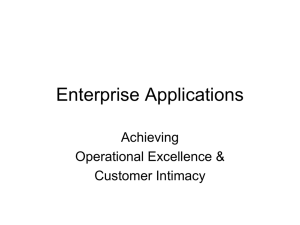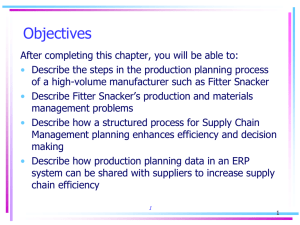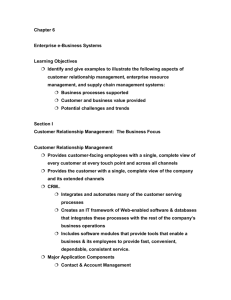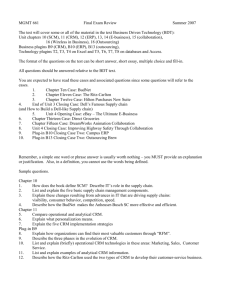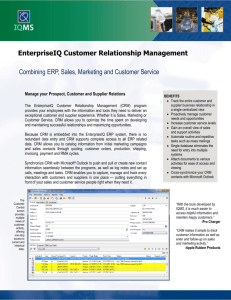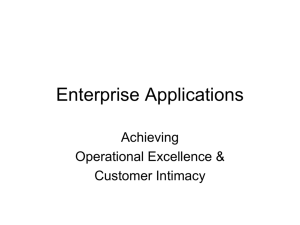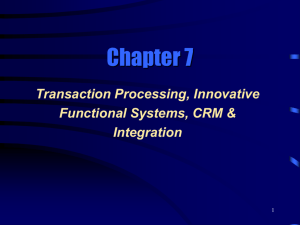MIS 2101 Summer 2012 Final Review
advertisement
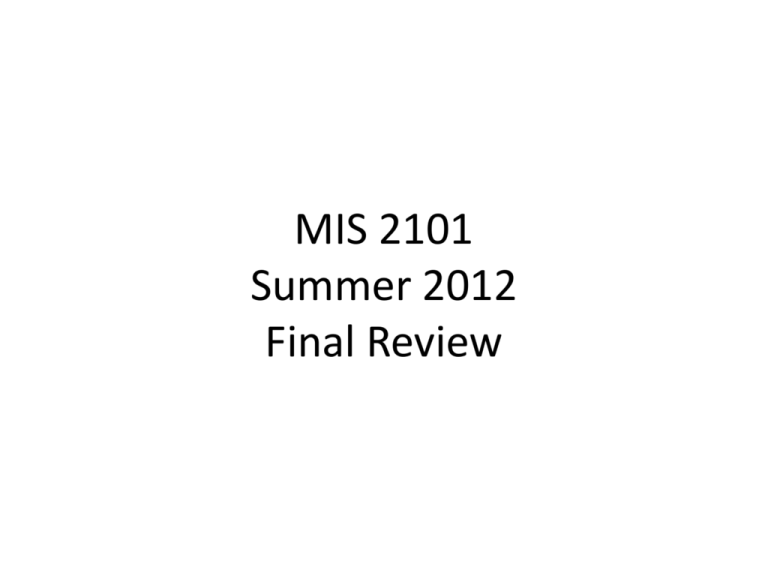
MIS 2101 Summer 2012 Final Review Enterprise System Approach Integrated Database Internally Focused Systems Enterprise Resource Planning Successful CRM Strategy The Formula for Enterprise System Success 1. 2. 3. 4. Secure executive sponsorship Get help from outside experts Thoroughly train users Take a multidisciplinary approach to implementations Tightly Integrated SCM vs. Portals Dell with Many Customers Elemica Big 3 with Many Suppliers Comprehensive CRM 8 Transactional Data • What is “transactional data”? Examples? • Is integration of transactional data across functional areas important? Overview of Fitter Snacker • What does Fitter Snacker make? • What are the names of the products? • How many sales divisions does Fitter Snacker have? • What are these sales divisions and who do they each sell to? Sales Order • Customers want delivery information when placing an order. How do they estimate delivery time? • How do sales clerks get information regarding credit? • Does this information reflect recent purchases, payments, or returns? • How do integrated information systems solve this problem? Whoops! Out of Stock • What can they do when they accept an order and find out that they are out of stock for part of the order? • How difficult is it to decide on the best option? • How many people needed to make the decision? • How do integrated information systems solve this problem? Delivery • What does “Delivery” mean in an SAP system? • What does ATP stand for? Core CRM Activities • What is “One-to-One Marketing”? • What is “Sales Force Automation (SFA)”? • What is “Sales Campaign Management”? Core CRM Activities • What are “Marketing Encyclopedias”? • What is “Call Center Automation”? SCM & Porter’s 5 Forces Can partnerships and investments in your supply chain give you a competitive advantage? 16 The Five Forces Model – Evaluating Business Segments Product returns Lower market Increased costsshare Competition in price, Lost customers Reduced quality and distribution service Electronic connections to more suppliers Reduced prices Lost market share 17 Decision support and business intelligence Reduce prices CAD product redesign Increase quality Value added services ERP toERP reduce reduce costs costs and presence reactBetter more CRM web quickly Lower costs improve through ERP, CAD/CAM quality supply chain, etc. Production Problems in “Unintegrated” systems Communication Inventory Accounting What are some of these problems? Making a Successful Business Case On what can we base a successful business case? Demand Strategies • If demand is greater than capacity… Option Result Choose not to meet the demand Lost sales Reduce promotional expenditures Potential lost sales Use overtime to increase capacity Increased costs Build up inventory in earlier periods 35 30 25 20 Supply Increased costs and lost inventory 15 Capacity 10 5 0 Time How a Computer Virus is Spread 21 MRP and ERP • What is MRP and what does it have to do with ERP? An integrated process Predicts future demand for products Sales Forecasting Starting Inventory Sales and Operations Planning Break production plan down into smaller time increments Create production schedule based on production plan from demand management Uses the schedule to determine products and 23 staffing Determines what company should produce Requires starting inventory levels and sales forecast based on capacity Demand Management Determines amount and timing of raw material orders Detailed Scheduling MRP Production Purchasing Takes quantity and timing information from MRP and creates orders for suppliers Measuring Productivity Strategizing: Five Types of Organizational Strategies • What are “Organizational Strategies”? • Can technology be leveraged to create value supporting these strategies? Types of Accounting • What is the purpose of “Financial Accounting”? • What is the purpose of “Managerial Accounting”? The General Ledger (GL) in an Integrated System • What is the “General Ledger”? • When is the general ledger updated with a non-integrated system? How about with an integrated system? SAP Module Feeds to GL Sales and Distribution (SD) - Sales to Customer Accounts Receivable (AR) Entries Materials Management (MM) - Purchase Orders made in Accounts Payable (AP) Entries Payroll Processing (HR) Expense Entries Financial Accounting (FI) - Manages the AR and AP items created in SD and MM GL accounts closed in FI at end of a fiscal period Question • What do we mean when we say a company has do “close its books”? • How often does a company do this? • How complicated is this? Sarbanes-Oxley Act of 2002 • Requires public company’s annual report contain management’s internal control report • Must include documentation of controls • An integrated information system provides tools to implement internal controls – Controls cannot necessarily prevent effort to circumvent standard processes • Companies with ERP systems will have an easier time complying with Sarbanes-Oxley Cybersquatting • What is “Cybersquatting”? • What protection do organizations have against cybersquatting? Another Look: CRM Success and Failure • CRM is often incorrectly viewed as a technology implementation driven by the IT department • CRM should be viewed as a business strategy • CRM tools can help identify the most profitable customers IS and Value Chain Analysis What are specific examples of how these IS functions add value and help create competitive advantages? Why might it be important for systems supporting these activities to function at an enterprise level? 32 Demand Strategies • If demand is greater than capacity… Option Result Choose not to meet the demand Lost sales Reduce promotional expenditures Potential lost sales Use overtime to increase capacity Increased costs Build up inventory in earlier periods 35 30 25 20 Supply Increased costs and lost inventory 15 Capacity 10 5 0 Time Bill of Material • What is a BOM? Ingredient Oats (lb) Wheat germ (lb) Cinnamon (lb) Nutmeg (lb) Cloves (lb) Honey (gal) Canola Oil (gal) Vit./Min. Powder (lb) Carob Chips (lb) Raisins (lb) Protein Powder (lb) Hazelnuts (lb) Dates (lb) Quantity NRG-A NRG-B 300 250 50 50 5 5 2 2 1 1 10 10 7 7 5 5 50 50 50 30 70


